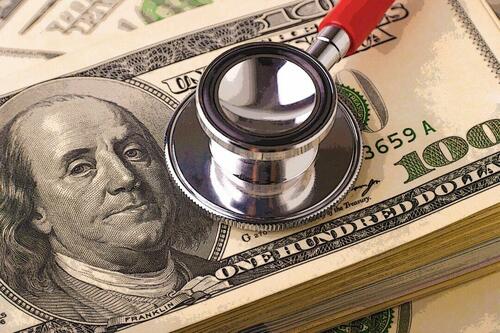
ER Editor: Alas, this isn’t a report on a European country but it will do. It well illustrates the extent of corrupted medicine.
This is the research letter linked to below from JAMA Network, relying as it does on data in the Open Payments database established in 2013 to record a variety of of payments and benefits to doctors. We wonder if this could be an understatement or under-reporting, just as medical reporting of, say, vaccine injury is underreported —
Industry Payments to US Physicians by Specialty and Product Type
Notice below that two of the top 3 drugs most associated with payments to doctors deal with blood clots, and both pharmaceutical companies – Johnson & Johnson / Janssen and Bristol Myers Squibb / Pfizer – put out lucrative Covid vaccines, which cause blood clots.
But would any of these ‘medicines’ have worked anyway given what we know about the rubbery/plastic nature of the clots that have killed people? Examples from 2022 —
SHOCKING: White Embalmer Clots Are Self-Assembling Circuits [VIDEO]
Worldwide Exclusive: Embalmers Find Veins & Arteries Filled with Never Before Seen Rubbery Clots
********
“Insane”: US Physicians Received Billions From Pharmaceutical And Medical Device Industry, New Research Finds
Authored by Megan Redshaw via The Epoch Times
U.S. physicians received more than $12 billion in payments from the pharmaceutical and medical device industry over a 10-year period, according to a new analysis.

A research letter published on March 28 in the Journal of the American Medical Association found that the industry made over 85 million payments to more than 820,300 (57 percent) of eligible physicians across 39 specialties from 2013 to 2022. Nearly 94 percent of the payments were related to one or more marketed medical products.
Researchers examined data in the Open Payments database to determine what payments were made across different specialties and the medical products associated with the largest total payments. Data only included payments received for consulting, non-consulting (such as speaker or faculty fees), travel, food, entertainment, education, gifts, grants, charitable contributions, and honoraria.
The Open Payments database is a federal transparency program that was established in 2013 out of concern that financial relationships between physicians and the industry were unduly influencing healthcare decision-making and costs.
The analysis found that payments varied considerably between specialties and among physicians of the same specialty. For example, the mean amount paid to the top 0.1 percent of physicians ranged from $194,933 for hospitalists to $4.8 million for orthopedic surgeons, while the payments to the median physicians ranged from zero to $2,339.
Orthopedic physicians received the greatest sum of payments, $1.4 billion, followed by neurologists and psychiatrists, $1.3 billion, cardiologists, $1.3 billion, and hematologists/oncologists, $825.8 million. Nearly 55 percent of pediatricians and 63 percent of infectious disease physicians received payments from the industry, while physicians practicing preventative medicine received the least sum of payments.
“From 2013–2022, pharma paid 12 billion dollars to U.S. physicians. That’s mind-boggling. Insane. That’s how silence is bought, the minds of physicians influenced, and ultimately patient care/prescribing patterns influenced,” Dr. Manni Mohyuddin, an oncologist, hematologist, and assistant professor at the Huntsman Cancer Institute, told The Epoch Times.
Dr. Mohyuddin emphasized that the average payment received was low, but some physicians received a significant amount of money and have influence over writing guidelines, chairing committees, clinical trials, influencing opinions, and more.
Top Drugs and Devices Associated With Payments
The top three drugs associated with the most payments were Xarelto ($176.3 million), Eliquis ($102.6 million), and Humira ($100.2 million).
Xarelto, jointly developed by Johnson & Johnson’s Janssen Pharmaceuticals and Bayer, is used to prevent and treat blood clots. Janssen also created the Johnson & Johnson COVID-19 vaccine, which caused rare and sometimes fatal blood clotting disorders.
Eliquis is a multibillion-dollar blood thinner manufactured by Bristol-Myers Squibb and Pfizer. The drug in 2023 was 12 percent of Pfizer’s total revenue—second only to its Comirnaty COVID-19 vaccine. Pfizer’s COVID-19 vaccine has also been linked to blood clotting disorders.
Humira is an immunosuppressive drug manufactured by AbbVie to treat arthritis, plaque psoriasis, ankylosing spondylitis, Crohn’s disease, and ulcerative colitis. Following the top three drugs are Type 2 diabetes medications Invokana, Jardiance, and Farxiga.
According to the analysis, the three medical devices associated with the most payments were daVinci Surgical System, $307.5 million, Mako SmartRobotics, $50.1 million, and CoreValve Evolut, $44.8 million.
‘Highly Targeted to Lucrative Procedures’
“Our paper is a modest analysis. It does not explain the problem of financial conflicts of interest. But it is a lot of money. And it’s highly targeted to lucrative procedures,” co-author and cardiac electrophysiologist Dr. John Mandrola wrote in a post on Substack.
Dr. Mandrola believes that the strong influence of the industry can be seen in the approval of numerous medical devices by the U.S. Food and Drug Adminsitration despite “dodgy evidence.”
“Cardiology is a technical field. We use devices. Innovation requires some collaboration. Innovation has made cardiology better. But industry influence is way too strong,” he said. Dr. Mandrola believes the payments reported in their paper are not only for physician–industry collaborations, but are for marketing and goodwill, which helps establish practice patterns among physicians.
The industry is profit-driven, and if direct payments to doctors didn’t work, the industry wouldn’t spend billions doing it, he added.
Payments Can Create Conflicts of Interest
Dr. Andrew Foy, co-author and cardiologist, told The Epoch Times in an email the analysis shows a strong relationship between physicians and industry, but there are other indicators of this relationship as well. For example, it’s not uncommon for industry ads to be featured on homepages of major medical journals or for a medical conference or meeting to bombard physicians with industry advertising.
“When I experience this at conferences, I feel like industry is not only welcome at these events but that the event is built around industry and its involvement,” Dr. Foy said. “There’s certainly no attempt to hide these relationships. The main reason being, at least in my opinion, is that many physicians, perhaps even the majority, believe the physician-industry collaboration is a net benefit to patients and society.”
Dr. Foy said he doesn’t necessarily share that view, but he doesn’t believe there is strong, objective evidence to support one side or the other as it relates to the overall benefits or harms of the relationship between physicians and industry.
“At this moment in time, the profession seems only interested in transparency. ‘As long as everyone is transparent, then everything is fine.’ As if someone cannot be transparent about their conflicts and highly biased at the same time,” he said.
Dr. Foy said he worries that conflicts of interest directly related to physician–industry payments may lead to overly enthusiastic recommendations or guidelines from medical organizations to use new products, even if they have not been sufficiently tested or where the evidence is not strong enough to recommend them over an old standard, or in some cases, nothing at all.
Additionally, Dr. Foy said a “major problem” with physician–industry payments is that they “have a way of tilting physicians sympathy toward industry” and the industry’s “medical advancements” which encourage physicians to more willingly adopt new products for the sake of “industry advancement,” even if they don’t have a direct conflict of interest with that particular product.
“In a way, they become cheerleaders for industry and more open to adopting new products simply due to this attachment,” Dr. Foy told The Epoch Times.
“I think what our paper does do is provide some numbers, which some may find shocking, and hopefully it renews interest in having conversations about physician-industry payments and conflicts of interest and perhaps facilitates more research,” he added.
Source
Featured image source: https://www.bostonmagazine.com/health/2015/12/23/white-coats-petition/
************

••••
The Liberty Beacon Project is now expanding at a near exponential rate, and for this we are grateful and excited! But we must also be practical. For 7 years we have not asked for any donations, and have built this project with our own funds as we grew. We are now experiencing ever increasing growing pains due to the large number of websites and projects we represent. So we have just installed donation buttons on our websites and ask that you consider this when you visit them. Nothing is too small. We thank you for all your support and your considerations … (TLB)
••••
Comment Policy: As a privately owned web site, we reserve the right to remove comments that contain spam, advertising, vulgarity, threats of violence, racism, or personal/abusive attacks on other users. This also applies to trolling, the use of more than one alias, or just intentional mischief. Enforcement of this policy is at the discretion of this websites administrators. Repeat offenders may be blocked or permanently banned without prior warning.
••••
Disclaimer: TLB websites contain copyrighted material the use of which has not always been specifically authorized by the copyright owner. We are making such material available to our readers under the provisions of “fair use” in an effort to advance a better understanding of political, health, economic and social issues. The material on this site is distributed without profit to those who have expressed a prior interest in receiving it for research and educational purposes. If you wish to use copyrighted material for purposes other than “fair use” you must request permission from the copyright owner.
••••
Disclaimer: The information and opinions shared are for informational purposes only including, but not limited to, text, graphics, images and other material are not intended as medical advice or instruction. Nothing mentioned is intended to be a substitute for professional medical advice, diagnosis or treatment.





Leave a Reply